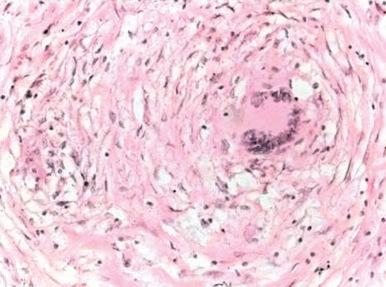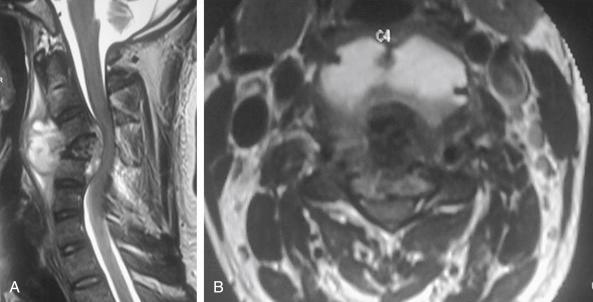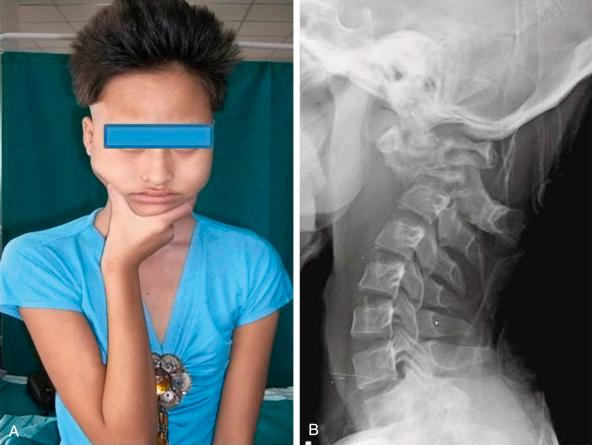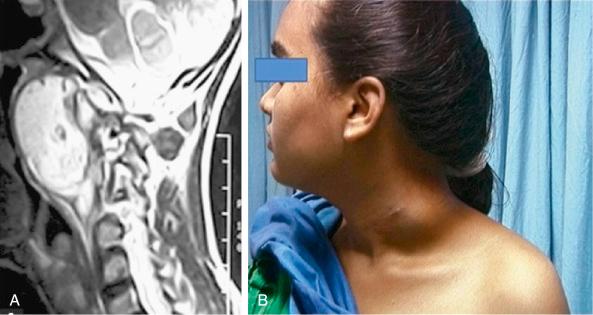Physical Address
304 North Cardinal St.
Dorchester Center, MA 02124
|
|
|
|
Tuberculosis (TB) continues to be a global health care challenge, with a prevalence of 14 million cases and 9.4 million new cases detected every year. The increased susceptibility to coinfection in the presence of human immunodeficiency virus infection (HIV) and the emergence of drug resistant strains have led to a higher burden of the disease worldwide.
Of the patients with TB, 10% to 15% have involvement of the musculoskeletal system, and spinal infections account for nearly half of these cases. Cervical spine involvement is relatively uncommon and accounts for only 10% of all cases of spinal TB. C1 and C2 involvement is rare, with an incidence of only 1%. However, the importance of cervical TB lies in its potential to cause of instability of the craniovertebral junction and of the atlantoaxial and subaxial cervical spine that can result in severe neurologic deficit and even sudden death secondary to acute cervicomedullary compression.
Unlike the other regions of the spine where spread of infection is hematogenous, bone involvement in the cervical spine TB is usually secondary to direct spread from retropharyngeal lymph nodes. The infection spreads from the retropharyngeal tissues to involve the bone and ligamentous stabilizers and results in instability and deformity. Vertebral body involvement is common in the cervical spine, whereas in thoracic and thoracolumbar TB paradiskal involvement predominates.
In early disease of the upper cervical spine, the diagnosis is usually delayed until an advanced stage because of the nonspecific nature of symptoms and paucity of findings in plain radiographs. In the C1-C2 complex, the lateral masses of atlas are involved in 72% and the dens in 62% of the patients. Destruction of bony elements of C1 and C2 can lead to dangerous instability and rotatory deformities of the craniovertebral junction ( Fig. 26-1 ). The intervertebral disks are relatively resistant to TB because of their avascular nature and low oxygen tension and hence may remain intact even in the presence of severe bone destruction. In the subaxial spine, and especially in children, destruction of an entire vertebral body is common, and it leads to cervical kyphotic deformity and instability with a potential threat to the spinal cord. Effective antitubercular chemotherapy along with traction or immobilization results in healing in early stages, whereas surgical intervention may be necessary in advanced disease associated with severe neurologic deficit, deformity, or instability.

TB is caused by bacilli of Mycobacterium genus, and Mycobacterium tuberculosis is responsible for most human infections. The bacilli possess a cell wall rich in mycolic acid, which is impervious to the Gram stain. This bacilli have acid-fast properties on Ziehl-Neelsen staining, hence the name acid-fast bacilli. The organism is an obligate aerobe and has affinity for tissues with high oxygen tension.
Under the microscope, the lesions produce a typical picture in which the tubercle bacilli are engulfed by mononuclear cells, which then coalesce to form epithelioid cells. The epithelioid cells are then encircled by lymphocytes to form the tuberculous granuloma ( Fig. 26-2 ). Caseating necrosis develops in the center of this granuloma. As the inflammatory process progresses, the extent of bone destruction and liquefaction increases to form an abscess, which is a collection of caseous material, bony sequestra, serum, and polymorphonuclear leukocytes with scant tubercular bacilli. The abscess may be confined to the prevertebral space, or it can track along the tissue planes to distant locations such as the anterior or posterior triangle of neck or in the axilla and along the brachial plexus sheath. Here the usual hallmarks of an acute inflammation of an abscess are absent, thus earning the name “cold abscess.”

Neurologic deficit in spinal TB results from mechanical compression of the spinal cord, direct dural infiltration, or ischemia of the spinal cord secondary to vascular thrombosis. The incidence of neurologic deficit in cervical TB varies widely between the upper and lower cervical spine. The spinal cord occupies only one third of the spinal canal at the level of C1 and C2, and the free space available makes neurologic deficit uncommon. Neurologic deficit is observed only with extensive destruction and large abscesses, which may result in atlantoaxial dislocation or basilar invagination with cervicomedullary compression causing quadriplegia, respiratory compromise, and even sudden death. The space available for the spinal cord is much less in the subaxial cervical spine, and hence lesions of this region are associated more commonly with early onset of neurologic deficit ( Fig. 26-3 ).

The age of the patient influences the clinical presentation and long-term outcome. In children less than 10 years old, the fulcrum of cervical spine motion is at the C2-C3 disk level because of the relatively large size of the child’s head. The increased mechanical stress makes the upper cervical spine a common location of TB in this age group. Younger children also have increased ligamentous laxity, poor muscle control, and horizontally oriented facets that predispose them to extensive destruction of growth plates, collapse, and severe kyphosis. Larger abscess formation and multiple-level involvement of the cervical region are also observed in the younger age group. By the age of 10 years, the facets become vertical, and the fulcrum of movement is shifted to the midcervical spine, thereby making this region more susceptible in patients more than 10 years old. The propensity for large abscess formation and kyphotic deformity is also lower in adults.
The usual presenting symptoms of cervical spine TB are pain and restriction of movements of the neck. Occipital headache can be a presenting symptom in craniovertebral TB. Constitutional symptoms of fever, loss of weight, and appetite are also common but can be absent in patients who are well nourished and who have good immunity. Early lesions, especially of the upper cervical spine, can easily be missed because the clinical symptoms are nonspecific and changes in plain radiographs may appear late. Suspicion of infection must prompt investigations with computed tomography (CT) or magnetic resonance imaging (MRI) scans, which will reveal the diagnosis very early.
Late diagnosis leads to destruction of bone with subsequent instability and deformity. The patient frequently supports the chin with hands to alleviate pain and to stabilize the cervical spine ( Fig. 26-4 ). Torticollis may also be present and may reflect sternocleidomastoid spasm or lateral mass destruction of atlas with instability.

Rarely, the presenting feature of cervical TB can be swelling in the neck secondary to cold abscess. The features of cold abscess vary with the site of tracking of the pus. The pus from the upper cervical region may manifest as a retropharyngeal abscess or as swelling in the posterior triangle of the neck, or it may spread beneath the prevertebral fascia into the mediastinum. Large retropharyngeal abscesses can manifest with dysphagia, dyspnea, and dysphonia ( Fig. 26-5 , A ).

In severe cases, cervical TB may also result in respiratory stridor, referred to as Millar asthma. Pus from the subaxial cervical spine may also track along the deep cervical fascia to appear in the anterior triangle of the neck, sternocleidomastoid, or trapezius. It can also manifest as swelling in the supraclavicular fossa, axilla, or elbow by gravitating along the brachial plexus ( Fig. 26-5 , B ). Concomitant cervical lymphadenopathy with or without draining sinuses may also be observed in some cases. Rarely, cervical TB may manifest with an isolated kyphotic deformity causing minimal clinical symptoms.
Neurologic symptoms of varying degrees are seen in nearly 25% of patients with TB of the cervical spine. In the active phase of the disease, granulation tissue, pus, and other debris can compress the spinal cord (see Fig. 26-3 ). Although the reported incidence of spinal cord compression noted on MRI in craniovertebral TB is 42%, the incidence of neurologic deficit is only 15% to 20%. Instability or deformity of the involved vertebrae can cause neural compression both in the active phase and in the healed phase.
Symptoms of spinal cord compression include altered gait pattern, spasticity, weakness, and paresthesias of extremities with loss of bowel and bladder control. Sudden death has also been reported following atlantoaxial instability and cervicomedullary compression secondary to upper cervical TB. Vertebral and basilar arterial thrombosis resulting in lower cranial nerve deficits, monoplegia, and hemiplegia has also been reported following cervical TB.
Clinical examination reveals tenderness of the affected cervical segments and torticollis with associated paracervical muscle spasm. All the movements of the neck are severely restricted by pain and spasm. Rarely, kyphotic deformity can be visualized with a palpable knuckle or gibbus. In patients with compression of the cervical spinal cord, upper motor neuron signs of exaggerated reflexes, extensor plantar response, spasticity, and clonus can be elicited. Gait should be carefully analyzed to document subtle signs of unsteadiness that may be the only sign of cord compression. A careful neurologic evaluation must be performed to document the power of the muscles of both upper and lower limbs, with evaluation of the bowel and bladder. Respiratory and abdominal examinations should be done to detect any other focus of infection.
Become a Clinical Tree membership for Full access and enjoy Unlimited articles
If you are a member. Log in here